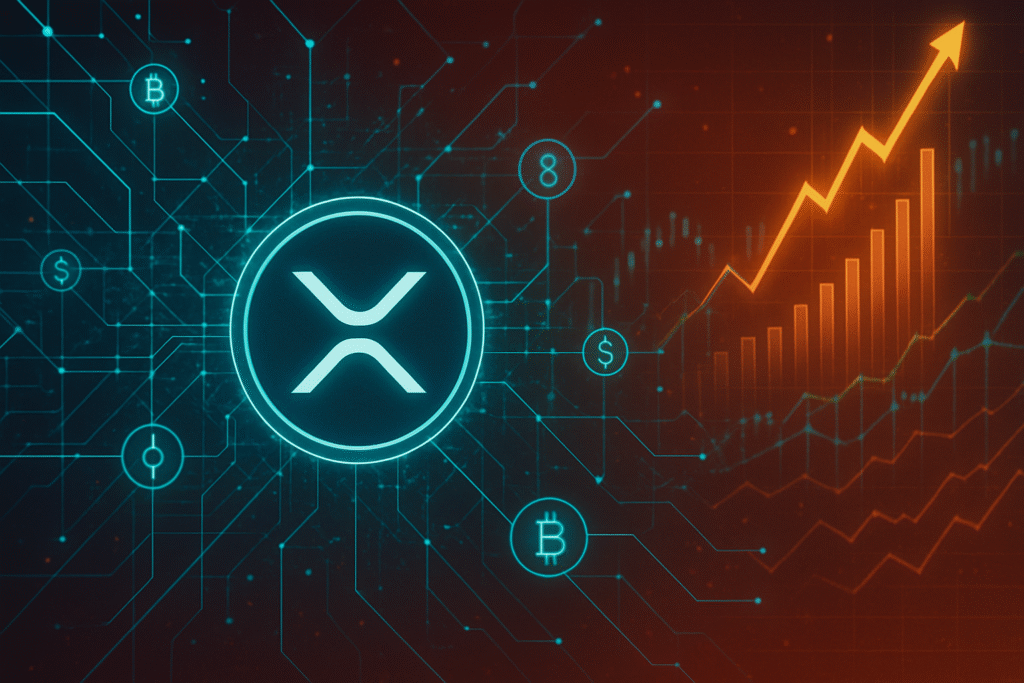
A bold prediction by Dom Kwok, a former Goldman Sachs analyst and co-founder of EasyA, has sent ripples through the cryptocurrency community: XRP, the digital asset powering Ripple's payment network, could soar to an astonishing $1,000 by 2030. This audacious forecast, rooted in XRP's real-world utility and anticipated institutional adoption, has ignited a fervent debate among investors and enthusiasts, highlighting the deep divisions and high stakes in the volatile crypto market.
Kwok's analysis, which positions XRP as far more than a "meme coin," emphasizes its role in cross-border payments for financial institutions, its growing integration into Decentralized Finance (DeFi), and the potential for XRP Exchange-Traded Funds (ETFs). The prediction also factors in a more favorable U.S. regulatory environment and Ripple's increasing use as a platform for tokenizing Real-World Assets (RWAs). While XRP maximalists have celebrated this as validation of their long-held belief, a significant portion of the community has reacted with skepticism, questioning the mathematical feasibility of such a valuation and its implied multi-trillion-dollar market capitalization. Another former Goldman Sachs analyst, Sheila Warren, publicly countered the notion, stressing that "The value of a payment network is not linearly related to the price of the token," underscoring the complexity of valuing such an asset.
Market Impact and Price Action
As of October 15, 2025, XRP is trading at approximately $2.49 to $2.50 USD, having experienced some short-term dips in recent weeks, including a -0.49% decline in the past 24 hours, a -12.66% decrease over the last week, and a -17% drop over the past month. Despite this recent volatility, XRP has delivered an impressive 355.18% gain over the last year, reaching an all-time high of $3.66596 on July 17, 2025.
The market's reaction to ambitious price predictions like Kwok's is often multifaceted. While such forecasts can generate significant buzz and optimism, their direct influence on immediate price movements is typically less pronounced than fundamental factors or technical indicators. For instance, XRP's 24-hour trading volume currently hovers between $5.53 billion and $8.23 billion, with recent fluctuations reflecting broader market sentiment and whale activity. A notable event occurred on October 10, 2025, when XRP experienced a severe 45% intraday flash crash, plunging from $2.83 to $1.53 within hours. This was largely attributed to President Trump's threat of 100% tariffs on China, triggering a widespread crypto market sell-off and cascading liquidations of leveraged positions. XRP has since shown resilience, stabilizing near $2.58.
Technically, XRP faces immediate resistance levels around $2.59, $2.65 (50-day Exponential Moving Average), and $2.70. A critical breakout above the $3.15 mark would be necessary to target higher levels, potentially reaching $3.60-$5.00. Key support levels are identified around $2.35, $2.42, and $2.54, with stronger long-term support between $1.45 and $1.68. While some moving averages signal a "strong sell," the 200-day moving average has been trending upwards since March 2025, suggesting an underlying strong trend. The Relative Strength Index (RSI) is neutral at 54, but a weekly Stochastic RSI in deeply oversold territory historically precedes major reversals, offering a glimmer of bullish hope.
Past ambitious predictions, ranging from $10 to $13,000, have often circulated within the XRP community. While they foster discussion, market analysts generally caution that XRP's large market capitalization makes triple or quadruple-digit returns less likely in the short term. Regulatory developments, particularly the ongoing review of spot XRP ETF applications (with six major applications pending SEC rulings between October 18 and 25, 2025), are considered far more significant potential catalysts, capable of attracting billions in institutional capital.
Community and Ecosystem Response
The $1,000 XRP prediction has undeniably fueled a vibrant, albeit divided, discussion across social media platforms like X (formerly Twitter) and Reddit. On X, while many users engage in "fun debate" rather than serious financial forecasting, the consistent chatter underscores a deep-seated interest in XRP's potential. Reddit threads reveal a similar dichotomy: staunch believers cite XRP's utility in global finance and a potential "supply shock," while skeptics dismiss the idea as "outrageous" due to market capitalization concerns. A palpable sense of frustration also exists among retail XRP traders, who have observed the asset's "lackluster price performance" compared to other cryptocurrencies, leading to "massive FUD" (fear, uncertainty, and doubt) and a drop in bullish sentiment.
Crypto influencers and thought leaders also offer varied perspectives. Armando Pantoja, a market expert, "definitely" believes XRP will reach $1,000 but stresses it will be a "marathon, not a sprint," drawing parallels to Bitcoin's early struggles. Analyst BarriC similarly deems $1,000 "inevitable," urging accumulation based on anticipated institutional demand. Others, like Jake Claver of Digital Ascension Group, are more aggressive, forecasting $1,500-$2,000 by January 2026, citing a "reverse carry trade" and global liquidity crisis. However, claims that Ripple co-founder Chris Larsen once suggested XRP could surpass $1,000 if Ripple captured 10% of SWIFT's global payment volume have been largely debunked as unsubstantiated rumors. Many proponents of the $1,000 target often dismiss market cap arguments, asserting that crypto market dynamics differ from traditional stock markets and that significant institutional adoption could drastically alter XRP's valuation.
While the $1,000 prediction itself hasn't directly triggered a surge in related DeFi protocols, NFT projects, or Web3 applications, the underlying arguments for such a high valuation intersect with ongoing developments within the XRP ecosystem. The XRP Ledger (XRPL) is actively fostering a DeFi environment, with Circle (USDC) launching its stablecoin on the XRPL and the introduction of native Automated Market Maker (AMM) pools. Flare Networks has also launched XRP FI, offering lending and staking for XRP holders. These advancements are laying the groundwork for a more robust XRPL ecosystem. Furthermore, Ripple's strategic moves, including global licenses and the development of the RLUSD stablecoin, are seen as crucial for institutional adoption, which would indirectly benefit the entire XRPL ecosystem.
What's Next for Crypto
XRP's future, and its implications for the broader crypto market, are significantly shaped by recent regulatory clarity and its expanding utility. The August 2025 settlement in the SEC vs. Ripple lawsuit, which affirmed that programmatic sales of XRP are not securities, has been a "game-changer." This de-risking of the asset has fostered optimism for broader institutional engagement across the digital asset space, impacting not just XRP but potentially setting a precedent for other utility tokens.
In the short term, the anticipation of spot XRP Exchange-Traded Fund (ETF) approvals, potentially by October 2025, is a major catalyst. These approvals could unlock substantial capital inflows and further price appreciation. However, the market remains susceptible to volatility from "whale" selling activity, geopolitical risks like U.S.-China trade tensions, and broader macroeconomic uncertainties.
Long-term, XRP is positioned to become a leading "bridge asset" in the evolving Central Bank Digital Currency (CBDC) landscape and a default settlement layer for institutions handling cross-border liquidity. Ripple's focus on replacing traditional, slow infrastructure like SWIFT with a blockchain-based alternative makes XRP attractive for institutional users seeking efficient cross-border payments. The company has forged strategic partnerships globally, including with Absa Bank in South Africa for digital asset custody, and appointed BNY Mellon (NYSE: BK) as the primary custodian for its U.S. dollar-pegged stablecoin, Ripple USD (RLUSD), launched in 2024. Ripple's $1.25 billion acquisition of prime brokerage firm Hidden Road in April 2025 further strengthens its position in bridging traditional finance and digital assets.
XRP's utility extends beyond payments to digital asset exchange, CBDC implementation, and the tokenization of Real-World Assets (RWAs). The XRP Ledger is also evolving to support smart contracts and NFTs through upgrades like XLS-20 and the introduction of sidechain technology, which will add Ethereum smart contract compatibility.
For projects building on the XRPL, the enhanced regulatory clarity provides confidence to develop innovative applications. For investors, strategic considerations include assessing XRP's utility beyond speculation, monitoring ETF approvals, and managing risk in a volatile market. Possible scenarios include a Bullish Scenario (High Likelihood) driven by ETF approvals and institutional adoption, potentially seeing XRP reach $4-$5 near-term, and $8-$10 in the coming years, or even $50-$100 if it becomes a major corporate reserve asset. A Moderate Growth/Stabilization Scenario (Medium-High Likelihood) sees steady but not explosive growth, with XRP trading between $2-$5 by 2027. A Volatile/Bearish Scenario (Medium Likelihood, primarily short-term) could see continued price swings due to whale selling, macroeconomic events, or ETF delays.
Bottom Line
The ambitious $1,000 XRP prediction, while a significant talking point, underscores the profound belief held by some in its long-term potential, primarily driven by its foundational utility and growing institutional acceptance. For crypto investors and enthusiasts, the key takeaway is to focus on XRP's utility-driven nature as a bridge currency for cross-border payments and its expanding role in RWA tokenization and CBDC initiatives. The regulatory clarity gained from the SEC lawsuit is paramount, de-risking the asset and paving the way for broader institutional confidence and potentially, spot XRP ETF approvals.
XRP's long-term significance in the crypto ecosystem lies in its potential to modernize global payments, offering a faster, cheaper alternative to traditional systems. It is also setting a crucial regulatory precedent for digital assets, contributing to the broader legitimization of the crypto industry. This shift towards utility and integration with traditional finance is vital for widespread crypto adoption, demonstrating that digital assets can offer tangible solutions beyond speculative trading.
Important dates and metrics to monitor include the U.S. SEC's decisions on spot XRP ETF applications between October 18-25, 2025, and into November. The completion of SWIFT's ISO 20022 migration in November 2025 is another critical event, as XRP's compatibility could enhance its integration into mainstream financial operations. Investors should also track the growth of Ripple's On-Demand Liquidity (ODL), Real-World Asset (RWA) tokenization metrics on the XRPL, and XRP escrow reports. Finally, continued regulatory developments globally and technical price levels will be crucial indicators of XRP's trajectory. While the $1,000 target remains highly speculative for now, XRP's fundamental developments position it as a significant player in the future of finance.
This article is for informational purposes only and does not constitute financial or investment advice. Cryptocurrency investments carry significant risk.





